Advances in Colloidal Quantum Dots for Applications in the Visible Spectrum
Haiyan Chen, CEO
NNCrystal US Corporation, Fayetteville, Arkansas
Colloidal quantum dots (QDs) are nanometer-sized, single-crystalline semiconductor fragments that are synthesized and processed using solution techniques (Figure 1, left). Electronic states of colloidal semiconductor nanocrystals in this size regime are often substantially affected by quantum confinement (Figure 1, right), exhibiting strong size dependence. In addition, the band-edge electrons of a QD would be spatially confined within the inorganic nanocrystal (see Figure 1, left), leading to overlapping of electron and hole wavefunctions.
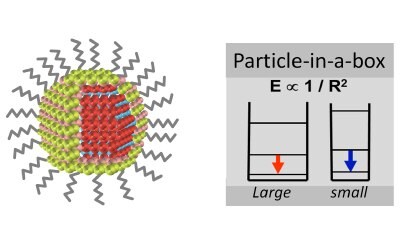
Figure 1.Left: Schematic illustration of a core/shell quantum dot with organic ligands. Right: Size dependent electronic states caused by quantum confinement, with the arrows showing size-dependent band-gap emission energy.
Electronic states and wavefunctions of band-edge electrons and holes dictate optical, electronic, optoelectronic, and chemical properties of materials. Due to this customizability, QDs have been actively pursued as a new generation of functional materials in recent years. In comparison to organic optical and optoelectronic materials, semiconductor nanoparticles are thermodynamically stable inorganic single crystals rendering outstanding optical, chemical, and thermal stability. Contrasting with inorganic phosphors and bulk semiconductors, QDs have a monolayer coating of organic ligands that allows them to be compatible with inexpensive and energy-saving solution techniques.
The controlled production of high quality QDs is essential to fully exploiting their great potential. Fortunately, the synthetic chemistry of semiconductor materials has advanced rapidly in the past 20 years. Using their patented technology of “greener approaches” as a foundation, our vender (NNCrystal US Corporation) further developed scale-up schemes and established a world-class industrial production facility for fabricating high quality quantum dots. This progressive resource offers excellent accessibility to this unique class of optical and optoelectronic materials for scientists and engineers worldwide.
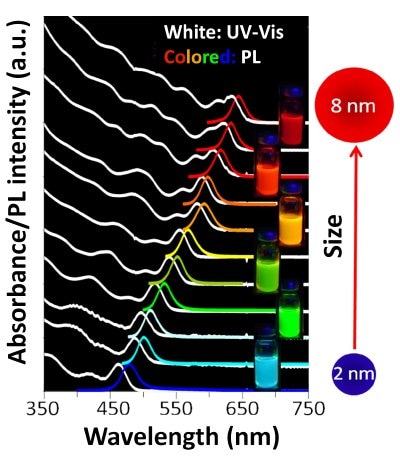
Figure 2.Size-dependent absorption and emission properties of CdSe quantum dots.
The absorption and emission spectra of quantum dots best demonstrate their size-dependent properties. Figure 2 depicts a series of absorption and photoluminescence (PL) spectra of CdSe QDs of varying sizes (CdSe core QDs are useful for demonstration of QD properties.) For clarity, the baseline of each set of UV-Vis absorption and PL spectra for a sample with a given size is offset from that of other samples with different sizes. From bottom to top, Figure 2 reveals significant red-shift of both UV-Vis absorption onset and PL peak along with increase of size of the quantum dots, caused by quantum confinement shown in Figure 1.
The PL spectra in Figure 2 are color-coded, demonstrating the beautiful and vivid colors of QDs (pictures of vials in Figure 2). Though the PL spectra of these quantum dots—synthesized ~15 years ago—are no longer the narrowest, their peak width is still extremely narrow in comparison with typical organic dyes and inorganic phosphors. The pictures are taken with CdSe quantum dots dissolved in a typical organic solvent (such as toluene or hexanes) under UV irradiation. These samples are stable as colloidal solutions under ambient conditions for years.
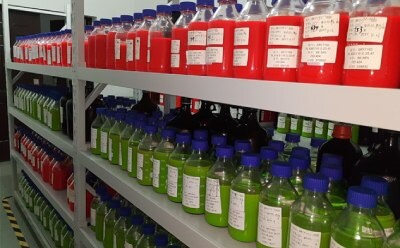
Figure 3.High-efficiency and stable quantum dots produced by large-scale production. Product color is due to highly-efficient emission through ambient-light excitation.
All spectra and pictures in Figure 2 are taken with CdSe QDs, which possess a bulk bandgap of ~1.72 eV (~720 nm). This bandgap, assisted by quantum confinement, enables synthesis of CdSe nanocrystals to cover most of the visible spectrum. With a different bulk bandgap, one could extend the optical window beyond the visible colors. For example, a bulk bandgap of ~1.35eV (InP) would provide QDs with near-infrared emission which is useful for bio-medical applications.
The size-tunable and sharp absorption characteristics illustrated in the PL spectra in Figure 2 were first observed many years ago. Emission efficiency (usually measured by quantum yield), reproducibility, and stability are equally important in these promising optical and optoelectronic materials. These issues have been largely solved in the past ten years, mainly through the synthetic management of QD surfaces.
Specifically, the application-relevant products of quantum dots are made using core/shell structures, i.e., well-controlled epitaxial growth of wide-bandgap shell semiconductor onto core QDs. The organic ligands of these core/shell QDs are optimized for high-efficiency as well as stable emission and have recently been released to the market by our vendor with industrial-standard quality control (see Figure 3).
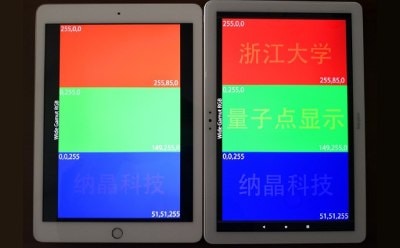
Figure 4.The same picture displayed by a regular LCD (left) and Quantum-Dot LCD (right). Extremely high color-resolution of the Quantum-Dot LCD allows the red and green characters to be displayed clearly in a similar colortone background.
Industrial applications of quantum dots have rapidly spread to many different industrial sectors. Due to their unique tunable emission color and extremely pure emission, QDs are often the best emitters for displays. Their emission characteristics in combination with their solution properties also promote their use in applications such as bio-medical labeling reagents.
With blue-emitting GaN LEDs as the electroluminescence source, red and green emitting color-controlled quantum dots are incorporated into polymer matrices as a new generation of back-lighting-units for liquid-crystal displays (LCDs). While this technology emerged just a few years ago, quantum-dot based back-lighting-units are already becoming a mainstream solution for improving LCDs (in particular, LCD TVs and computer displays).
On the market, these quantum-dot enhanced LCD TVs are known as QLED TVs, or more precisely Quantum-Dot TVs, which offer otherwise-not-available color quality and color resolution (Figure 4). In Figure 4, three sets of characters are embedded in three backgrounds with similar color tone. The regular LCD can only display the blue characters (Figure 4, left). With the same blue-emitting GaN LEDs, the Quantum-Dot LCD can offer a clear display of all three sets of characters (Figure 4, right) when using green and red-emitting QDs as the back-lighting units.
In 2014, a paper published in Nature demonstrated that it is possible to fabricate high-performance quantum-dot light-emitting-diodes (QLEDs) with outstanding device lifetimes.1 The QLEDs with different electroluminescence colors not only have outstanding color quality and information-display properties as shown in Figure 4 but are also fabricated through inexpensive solution processes resulting in their rapid worldwide progress as the next generation display technology. In addition to their use in the display industry, QLEDs are also explored as possibilities for solid-state lighting.
Other types of optoelectronic devices centered around QDs, such as solar cells and photodetectors, are also under intense investigation in both industry and academic laboratories.2-4 Contrasted with competitive technologies, devices based on QDs are fabricated with low-cost solution techniques, critical for large-scale applications such as solar cells. After 20 years of development effort, the performance of both quantum-dot solar cells and photodetectors has continued to advance rapidly, with power-conversion efficiencies approaching that of industrial products.
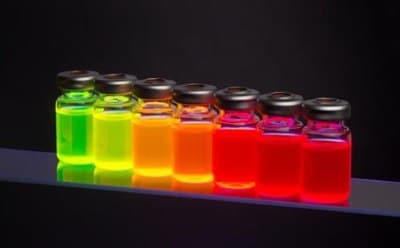
HECZ (Cadmium Selenide / Zinc Sulfide) Cadmium Based Quantum Dots
Performance Characteristics
|
Scope of Applications
|
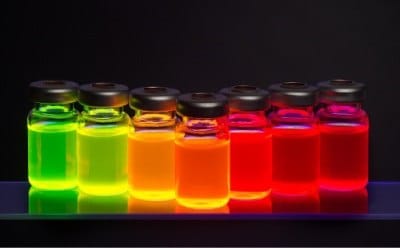
HECZWC (Cadmium Selenide / Zinc Sulfide -COOH) Cadmium Based Quantum Dots
Performance Characteristics
|
Scope of Applications
|
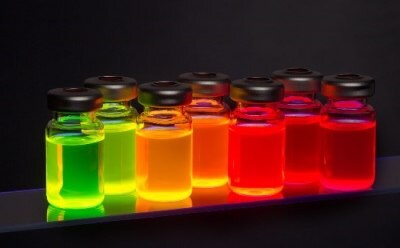
HECZWA (Cadmium Selenide / Zinc Sulfide -NH2) Cadmium Based Quantum Dots
Performance Characteristics
|
Scope of Applications
|
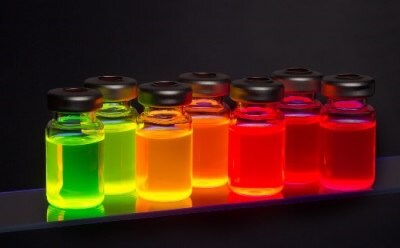
CIS (Copper Indium Sulfide / ZnS) Cadmium Free Quantum Dots
Performance Characteristics
|
Scope of Applications
|
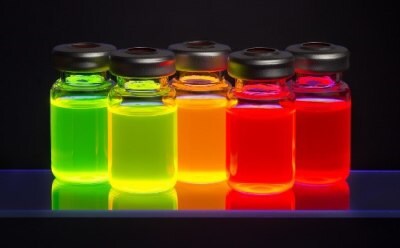
HEINP (High Efficiency Indium Phosphide / ZnS) Cadmium Free Quantum Dots
Performance Characteristics
|
Scope of Applications
|
Products
Response not successful: Received status code 500
References
To continue reading please sign in or create an account.
Don't Have An Account?